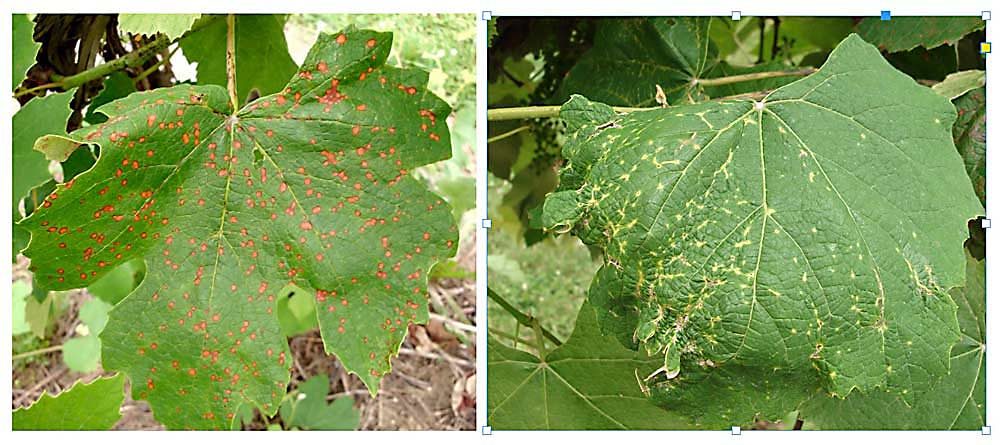
Grapes face all kinds of fungal diseases — from mildews, rots and blights to leaf spot and anthracnose. What’s a grower to do? Here are 11 tips from Annemiek Schilder, who spent many years as a small fruit pathologist at Michigan State University and now serves as director of the University of California Cooperative Extension in Ventura County.
1. Apply dormant sprays to reduce inoculum levels. She recommended lime sulfur, sulfur or copper formulations to kill fungal spores that overwinter on the vine. “This is one of the things people don’t always do, but especially if you had a lot of disease the previous year, dormant sprays are a good way to get a head start on the season,” Schilder said.
2. Cut it out. In addition to dormant sprays, growers should physically remove as much inoculum as possible, either by chopping up the prunings and burning them or burying large trunks to destroy fungal pathogens. “Cutting out diseased canes and clusters and pruning out dead wood will both help, and this is something you will want to do prior to the next season starting,” she said.
3. Open up that canopy. Open canopies have a number of benefits for disease control: They reduce relative humidity to discourage fungal attack, increase sunlight exposure to toughen fruit skins and kill fungal spores, and improve spray coverage, Schilder said. She suggested altering canopy density through strategic winter pruning, summer hedging or topping, and shoot positioning. In addition, leaf pulling is a good option to help control bunch rot.
4. Don’t let down your defenses. If a disease was a problem last season, growers should assume it’s still lurking, even if the vines start the season looking healthy. “It’s easy to think that maybe it won’t be as bad this year, but if it was bad last year, you’ll most likely see both earlier disease onset and higher disease levels,” Schilder said. “Unless you act early, you can get taken by surprise, because fungal diseases can come on suddenly and get bad really fast.”

5. Scout early, scout often. “It’s helpful to scout vineyards early in the season before bloom, because if you see a lot of black rot spots on the leaves, or Phomopsis on the canes and leaves, that indicates that you have inoculum waiting to attack your berries,” she said. From early season on, she recommends scouting at least once a week and focusing on the varieties that are most susceptible.
6. Use protectant and systemic fungicides. Protectants such as mancozeb and ziram can provide economical early-season control, especially for Phomopsis and black rot, and sulfur may be used for early powdery mildew control in cultivars that are not sulfur-sensitive, Schilder said. An additive, such as a spreader-sticker, may be helpful for ziram, as well as some other fungicides, to improve coverage and retention.
“Organic growers can use natural products such as copper, sulfur, oils, salts, and plant extracts, as well as biofungicides such as Double Nickel 55,” she said, but she cautioned that oils can burn leaves in hot temperatures. In that case, she suggested an option called TriTek, describing it as active against powdery mildew but with less burning.
Systemic fungicides are effective at low doses, provide good coverage and may have some “kickback action,” stopping recent infections from developing into disease, she said. They tend to be more rainfast than protectant fungicides but may require reapplication after 1 to 2 inches of rain. Schilder recommends applying systemic fungicides “during cloudy, humid conditions when the waxy cuticle of the plant allows faster fungicide uptake than during hot, dry weather.”
7. Consider fungicide resistance. To reduce the risk of grape pathogens developing fungicide resistance, growers should strive to make fewer fungicide sprays and alternate between fungicide groups, as delineated by the Fungicide Resistance Action Committee (FRAC) numbers on labels. This applies mostly to systemic fungicides. Schilder’s work, for instance, has shown resistance in powdery mildew to both strobilurins, the FRAC 11 group (e.g., Sovran, Flint, Abound, Pristine) and sterol inhibitors, FRAC 3, (e.g., tebuconazole, Rally, Mettle).
8. Watch the weather. Cool, wet weather favors downy mildew, black rot, Phomopsis and anthracnose, while a drier season will promote powdery mildew, so monitoring the weather is a must for determining what the fungal future holds. In addition, growers should keep a close eye on grape clusters, where moisture can linger.
“A cluster can be dry on the outside, but there could still be infection conditions inside. Black rot only requires six hours of wetness at 80 degrees to get into those clusters, for instance, so growers should really focus their protection on their clusters for at least four weeks after bloom,” Schilder said.
9. Spray well and wisely. “If you only want to apply a few disease sprays, focus on protecting the young fruit,” she said. That means spraying just after fruit set, two weeks later, and again before the cluster closes up. The latter helps fungicide get inside the cluster. Correct nozzle settings and calibration, as well as spraying every row, help ensure good coverage.
10. Apply, rain, repeat. If disease pressure is mounting during a wet spring, growers shouldn’t wait too long to get a fungicide applied, even if that means a rain may wash some off, she said. “You may have to reapply, but you don’t want to miss an opportunity to get at least something on the vines in case infection happens during that rainy period.”
11. Organize your vines. In new plantings, growers might consider grouping together certain disease-susceptible varieties in the vineyard, so they can spray only the blocks that need it. “Only one block may be susceptible to downy mildew, so instead of blasting the whole vineyard, which is what most growers do, you can just spray that block and reduce your fungicide expenses and footprint,” Schilder said. •
—by Leslie Mertz






As the viticulturist of the World’s only commercial vineyard growing Vitis vinifera with zero use of all pesticides, I disagree with many reccomendations in this article.
It is all about climate and canopy. Not choice of pesticides. Certainly hedging can be counter productive.
Most vineyards use trellis systems that Nelson Shaulis showed to be inadequate back in the seventies. We chose to grow in an area with high intensity sunlight (our solar panels at the moment are producing at 122% of rated capacity) and aridity.
We use the Crawford Trellis which is a variant of Lyre Trellis. VSP and other single cordon systems and vertically divided trellis systems require pesticides or very low vigor and low yields.
Paul Vandenberg
Paradisos del Sol
Hi Paul. Yes, we know you’ve got a unique perspective on how to farm without fungicides. Thanks! Readers who want to learn more about Paul’s approach can find details here: https://www.goodfruit.com/divide-to-conquer-pests/
Excuse me, but the fact that you (might) be the only zero pesticide commercial grower in the States does not imply you are the only zero pesticide commercial viticulturist of the whole world. Far from it!
Dear Paul,
Thank you for your comments and congratulations on having a pesticide-free vineyard, which is quite a feat! I agree with you that environmental modification is more important that most people realize. The divided trellis accomplishes that quite well. I wrote from the perspective of growing grapes in a humid climate, which is much more conducive to multiple fungal diseases than the semi-arid climate in Washington, and can be very challenging depending on the cultivar grown. A divided trellis may also complicate mechanical harvesting. Nonetheless, if more growers could adopt your system, it would reduce the need for fungicide applications, which is goal we should all aspire to. Thanks for offering an alternative solution!
If you are new to raising of grapes start with muskedine many kinds huge crops seedless very little spraying make great wine or jelly soon to try raisins an you can get with seeds (why) also one that makes huge fruit (less picking) mine will make 4to6 crops but only first will get ripe
Very new to grape growing, have some pink, Nigeria and Concord grapes. I spray a dormant spray with sticker and sulfur in the early spring but haven’t touched them with anything else since. Went out today and they are getting fat, green and healthy but I noticed some brown/black spots on some grapes. After researching I believe it black rot. My question is what do I do now? It’s July 6 th extremely hot in Michigan, can I spray Captan or a fungicide? I am very new as I mentioned to grape growing, I am not sure what will help and how much of each to use at this stage, their medium in size and it’s mostly on my Nigeria. I will open up canopy and pick the bad ones off but what else can I do, it happened over night, please help thank u in advance
Hi Tina,
We recommend reaching out to an extension specialist in your area for specific help on fungicide programs. Here’s a link to the Michigan State University Extension website: https://www.canr.msu.edu/outreach/.
My grapes are clustering and they are getting brown spots .I am also noticing on vines.. I have sprayed and used 2 different fungicides. Help!!
Can anything be done to grape vines and clusters to save them them from brown spots?
I have found an old vine which has been allowed to run wild and been neglected for about eight years . I have built a 8 foot high frame for it and am training it to run over the roof . We can see the fruit forming and I want to know if we an use the same mix of lime juice and water that we use on apple trees to ward off aphids and bugs .
I have (had) three beautiful 15 year old Marquis vines on a trellis in my yard. Two years ago over winter one died completely. Never showed any new growth in spring at all. This past winter I lost another, same thing no new growth dead vine! Also have two smaller vines in a row in garden, one of those died this past winter. Usually prune in spring but last year because of powdery mildew and black rot infestation did a fall pruning and fungal treatment. Any ideas why they would die suddenly over winter?
Hi Ron, you didn’t mention where you’re growing grapes, but we suggest you contact your nearest university extension office for help determining whether the winter temperatures or other factors are causing your vines to die. Good luck solving the mystery!
How to reduce density of grape cluster?
easy way, try gibberellic at 1 ppm, just at 75% bloom(it also elongated the bunch)